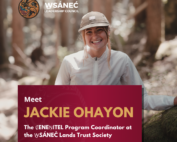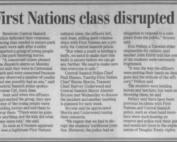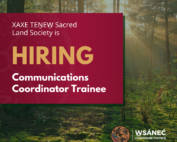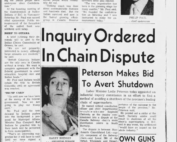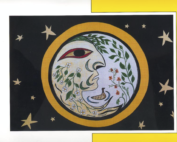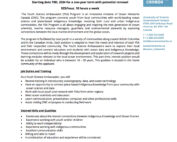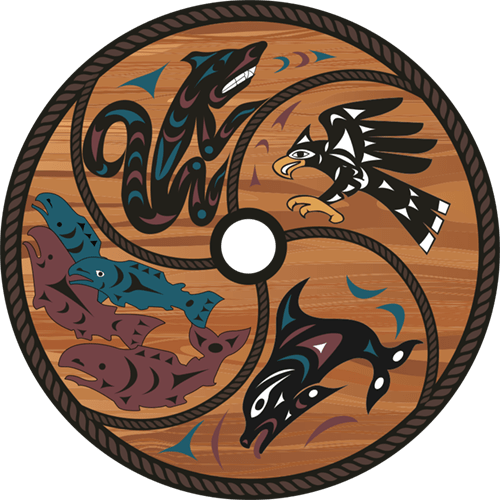Sacred object returned home to W̱SÁNEĆ
W̱SÁNEĆ Leadership Council (WLC) hosted a homecoming ceremony on Thursday, January 25, 2024. The ceremony marked the significant return of SDÁLṈEW̱, a sacred bowl set to be sold by settlers, but intercepted by SFU.
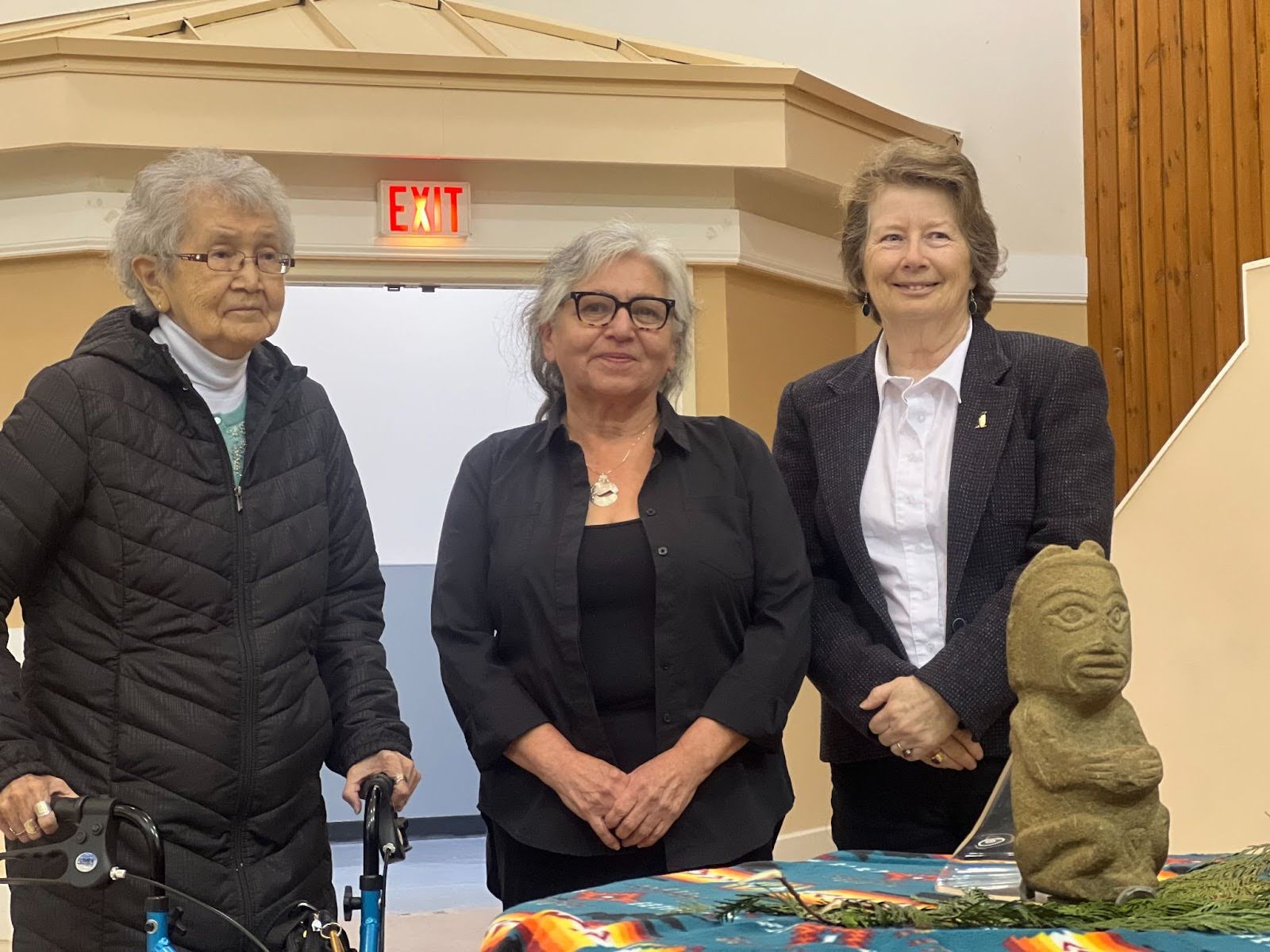
Shown above from left to right, Adelynne Claxton, Diana Henry, Former Director of SFU, Barbara Winter
Since arrival, settlers have appropriated and displaced countless W̱SÁNEĆ sacred objects. Outside of W̱SÁNEĆ care these objects are unable to serve their sacred purposes, and are instead shuttled worldwide as museum display pieces or elements of private collections without regard to their ancestral home.
In recent years, WLC has made significant efforts to raise awareness regarding the proper care of sacred objects. And, now – in part because of WLC’s awareness-building work – the WLC celebrates the long-anticipated return of SDÁLṈEW̱. She rejoined W̱SÁNEĆ on January 25th, 2024 after over 100 years in the hands of settlers. WLC Director of Operations ȻELOȽEMKEN (Gord Elliott) spoke to the profundity of her return, sharing:
The repatriation of SDÁLNEW̱ holds profound significance for our community; it resonates deeply within our collective spirit, echoing the wisdom of our elders and knowledge keepers. They have consistently imparted to us a sacred truth: these invaluable items, imbued with our heritage, do not belong in external institutions. Their rightful place is within the care of W̱SÁNEĆ, the very soil and soul where they were originally intended to reside. It is our duty, our heartfelt mission, to reunite our sacred items with our people, ensuring their protection and allowing them to fulfill their sacred purposes once again.
A Repatriation Summary by Simon Fraser University (SFU) Museum of Archaeology and Ethnology acknowledges what W̱SÁNEĆ records indicate: SDÁLṈEW̱ could be as many as 2,000 years old based on the origin dates of similarly-styled sacred objects. Thus, she has a longstanding relationship with W̱SÁNEĆ.
SDÁLṈEW̱’s path home to W̱SÁNEĆ was long and winding, as the settlers holding her failed to consult with W̱SÁNEĆ regarding her purpose and rightful home for over 90 years.
Settlers unearthed SDÁLṈEW̱ on unceded W̱SÁNEĆ land around 1900. At the time, the settlers living on the land used it as farmland.
Rather than seeking out SDÁLṈEW̱’s rightful home, the settlers retained SDÁLṈEW̱ on the farm, and settler publications took note. SDÁLṈEW̱ became well documented, with photographs and drawings of the figure appearing over the subsequent decades. And still, settlers did not consult W̱SÁNEĆ.
In the early 1990s, the farming family sold SDÁLṈEW̱ to a local antiquities dealer who intended to sell SDÁLṈEW̱ to a private collector in the United States. During the dealer’s export permit review, the Repatriation Summary states, “an expert recommended the application be denied, given the importance of SDÁLṈEW̱ to understandings of local archaeological and anthropological history.” This pause is the first in a chain of events that thwarted SDÁLṈEW̱’s international sale and helped her return home.
While the Cultural Property Export Review Board ultimately decided against denying the application, it did substantially delay the process to make time to find a Canadian purchaser. The Board alerted several Canadian museums of SDÁLṈEW̱’s availability for purchase.
When SFU’s Museum of Archaeology and Ethnology received notice of the SDÁLṈEW̱’s sale, they stepped in to ensure SDÁLṈEW̱ could return home. SFU notified the Saanich Native Heritage Society of SDÁLṈEW̱’s attempted sale and began crafting a plan to return SDÁLṈEW̱ to W̱SÁNEĆ. After consideration of best practices, SFU decided the most efficient route forward was for the SFU’s Dr. Barbara Winter, Museum to purchase SDÁLṈEW̱ with the intention of transferring title to W̱SÁNEĆ.
In 1994, the Museum completed a Transfer of Title, granting “ownership” of SDÁLṈEW̱ to W̱SÁNEĆ via the Saanich Native Heritage Society. The Museum agreed to care for SDÁLṈEW̱ until its return to W̱SÁNEĆ.
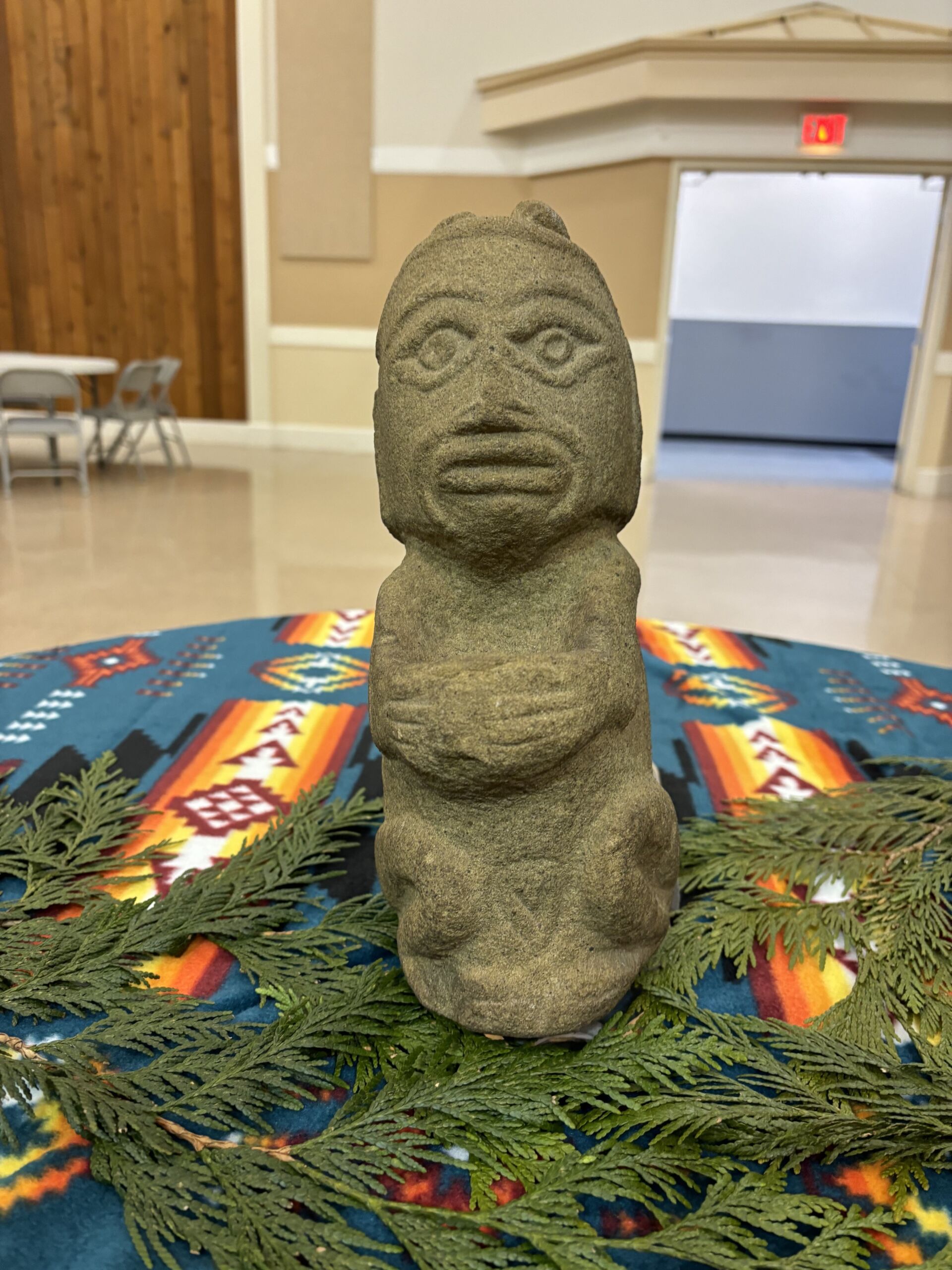
On January 25th, 2024, after 20 years of respectful care by the Museum, SDÁLṈEW̱ officially returned to W̱SÁNEĆ. To celebrate the return, WLC hosted a homecoming event at Saanich Fairgrounds, complete with traditional protocols and lunch for attendees. According to ȻELOȽEMKEN:
The ceremony marking the return of SDÁLNEW̱ was a deep and meaningful event, encapsulating the essence of our cultural heritage and spiritual connection. The return ceremony was woven with traditional protocols, including the practice of calling witnesses, which ensures that this historic moment is seen, remembered, and honored. The event also included a sacred blessing of SDÁLṈEW̱. We also took time to recognize and express our deep gratitude to those who played a pivotal role in thwarting the sale of SDÁLNEW̱ and ensuring her safe return. Their efforts symbolize a bridge of understanding and respect between our community and others.
Return of SDÁLṈEW̱ Reflects Success of WLC’s Archaeological Initiatives
This return of SDÁLNEW̱ is particularly significant in light of WLC’s current emphasis on archaeological projects. In recent years, WLC has focused on developing systems to protect and facilitate the return of sacred objects like SDÁLṈEW̱, an initiative which reflects WLC’s commitment to promoting “the interests of the W̱SÁNEĆ First Nations by enhancing recognition of, and respect for, W̱SÁNEĆ Douglas Treaty rights and W̱SÁNEĆ Aboriginal rights and title.”
For example, WLC established an Archaeology Committee to “guide archaeological and cultural heritage policy development and archaeological work in W̱SÁNEĆ territory,” created a Referrals Department to ensure proper care is taken during development, and developed Archaeology Procedures and content for a Protocol Agreement to guide development on a Canadian Food Inspection Agency property at the base of ȽÁU,WELṈEW̱.
Additionally, WLC established a working relationship with the Capital Regional District to ensure adequate consultation with W̱SÁNEĆ when embarking on projects which might disturb W̱SÁNEĆ sacred objects. This critical collaboration arose out of CRD’s Wastewater Treatment Plant Project, which uncovered W̱SÁNEC sacred objects. At the outset of the project, CRD failed to consult or obtain consent from W̱SÁNEĆ regarding parts of the project which required development in W̱SÁNEĆ territory. However, after much insistence on behalf of WLC, WLC and CRD entered into a working relationship to ensure ancestral remains would not be disturbed. This relationship also allowed WLC to properly study the materials uncovered in the course of the Wastewater Treatment Plant Project, resulting in insights regarding W̱SÁNEĆ’s long history in the area. This collaboration established a precedent which ensures adequate W̱SÁNEĆ involvement in future CRD projects.
These efforts have successfully generated increased settler awareness regarding the proper care of W̱SÁNEĆ sacred objects. SDÁLṈEW̱’s homecoming is one of the first tangible fruits of these efforts – demonstrating a development in settler understanding of the need to protect sacred objects and place them at home where they can fulfill their sacred purposes – and a hopeful indicator of ongoing, meaningful reconciliation.
In ȻELOȽEMKEN’s words:
We, the people of W̱SÁNEĆ, extend our most sincere appreciation and respect to former SFU Director Barbara Winter, Dianna Henry, Adelynne Claxton, the late Uncle Gabe Bartleman, and the current SFU Director, Barbara Hilden. Their unwavering dedication and perseverance were instrumental in safeguarding SDÁLNEW̱ from the uncertainties of the public market and guiding her back to her ancestral home. This act of returning SDÁLNEW̱ is not just a physical journey, but a powerful testament to the resilience and enduring spirit of our culture and our unbreakable bond with our past, present, and future.
To stay up to date on this story and others, sign up for our newsletter below.



